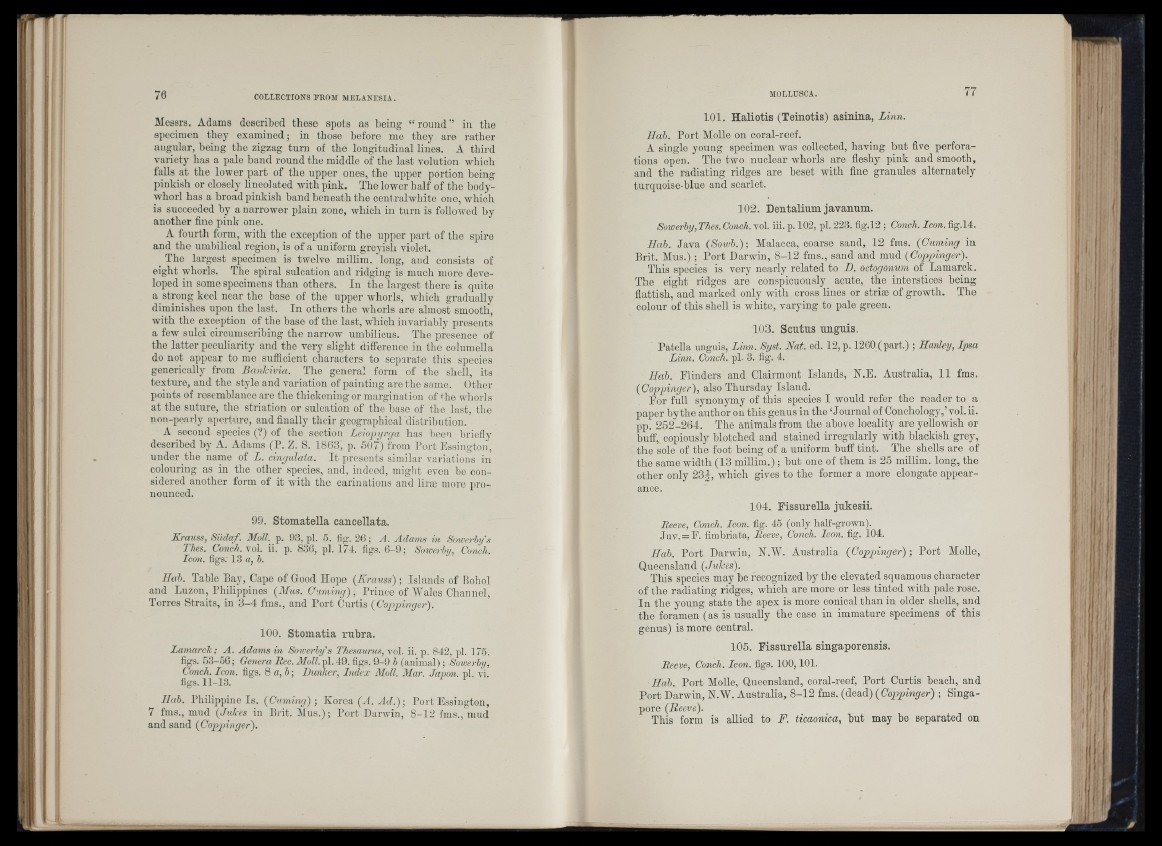
Messrs. Adams described these spots as being “ round ’’ in the
specimen they examined; in those before me they are rather
angular, being tho zigzag turn of the longitudinal lines. A third
variety has a pale band round the middle of the last volution which
faUs at the lower part of the upper ones, tho upper portion being
pinkish or closely lincolatcd with pink. The lower half of the body-
whorl has a broad pinkish band beneath the cent ralwhite one, which
is succeeded by a narrower plain zone, which in turn is folloiYcd by
another fine pink one.
A fourth form, with the exception of the upper part of the spire
and the umbilical region, is of a uniform greyish violet.
The largest specimen is twelve millim. long, and consists of
eight whorls. The spiral sulcation and ridging is much more developed
in some specimens than others. In the largest there is quite
a strong keel near the base of the upper whorls, which gradually
diminishes upon tho last. In others the whorls are almost smooth,
with the exception of the base of the last, which invariably presents
a few sulci circumscribing the narroAV umbilicus. The presence of
the latter peculiarity and the very slight difference in the columella
do not appear to me sufficient characters to separate this species
generically from Bankivia. The general form of tho shell, its
texture, and the style and variation of painting are tho same. Other
points of resemblance are the thickening or margination of khe whorls
at the suture, the striation or sulcation of the base of the last, the
non-pearly aperture, and finally their geographical distribution.
A second species (?) of tho section Leiopiirga, has been briefly
described by A. Adams (P. Z. S. 1863, p. 5U7) from Port Essington,
under the name of L. cinrjulaia. I t presents similar variations in
colouring as in the other species, and, indeed, might even be considered
another form of it with the carinations and lira? more pronounced.
99. Stomatella cancellata.
Krauss, S'ddaf. Moll. p. 93, pi. 5. fig. 26; A. Adams in Sowerhy s
Thes. Conch, yol. ii. p. 836, pi. 174. figs. 6-9; Soiverhy, Corich.
Icon. figs. 13 a, b.
Hub. Table Bay, Capo of Good Hope (Krauss) ; Islands of Bohol
and Luzon, Philippines (Mus. Caminrj) , Prince of AVales Channel,
Torres Straits, in 3 -4 fms., and Port Curtis (Coppinger).
100. Stomatia rubra.
Lamarck; A. Adams in Sowerby's Thesaurus, vol. ii. p. 842, pi. 175.
figs. 5-3-56; Genera Bee. Moll. pi. 49. figs. 9-9 b (animal); Sowerby,
Conch. Icon. figs. 8 a,b; Hunker, Index Moll. Mar. Janon. pi. vi.
figs. 11-13.
Ilah. Philippine Is. (Cuming)-, Xovea (A. A d .) ; Port Essington,
7 fms., mud (Jukes in Brit. Mus.); Port Darwin, 8 - 12 fms., mud
and sand (Coqipinger).
101. Haliotis (Teinotis) asinina, Linn.
Hah. Port Alolle on coral-reef.
A single young specimen was collected, having but five perforations
open. The two nuclear whorls are fleshy pink and smooth,
and the radiating ridges are beset with fine granules alternately
turquoise-hlue and scarlet.
102. Dentalium javanum.
Sowerby, Thes. Conch, vol. iii. p. 102, pi. 223. fig.l2 ; Conch. Icon. fig.l4.
Ilah. Java (Soivh.); Malacca, coarse sand, 12 fms. (Cuming in
Brit. Mus.) ; Port Darwin, 8-12 fms., sand and mud (Coppinger).
This species is very nearly related to D. octogonum of Lamarck.
Tho eight ridges are conspicuously acute, the interstices being
flattish, and marked only with cross lines or striæ of growth. The
colour of this shell is white, varying to pale green.
103. Scutus unguis.
Patella unguis, Linn. Syst. Hat. ed. 12, p. 1260 (part.) ; Hanley, Ipsa
Linn. Conch, pi. 3. fig. 4.
Hah. Elinders and Clairmont Islands, N.E. Australia, 11 fms.
(Coppinger), also Thursday Island.
For full synonymy of this species I would refer the reader to a
paper by the author on this genus in the ‘Journal of Conchology,’vol.ii.
pp. 252-264. The animals from the above locality are yellowish or
buff, copiously blotched and stained irregularly with blackish grey,
the sole of the foot being of a uniform buff tint. The shells are of
the same width (13 millim.) ; but one of them is 25 millim. long, the
other only 2 3 |, which gives to the former a more elongate appearance.
104. Fissurella jukesii.
Beeve, Conch. Icon. fig. 45 (only half-grown).
Juv. = F. fimbriata, Beeve, Conch. Icon. fig. 104.
Hah. Port Darwin, N.AV. Australia (Coppinger) -, Port Molle,
Queensland (Jukes).
This species may be recognized by the elevated squamous character
of the radiating ridges, which are more or less tinted with pale rose.
In the young state the apex is more conical than in older shells, and
the foramen (as is usually the case in immature specimens of this
genus) is more central.
105. Fissurella singaporensis.
Beeve, Conch. Icon. figs. 100,101.
Hah. Port Molle, Queensland, coral-reef, Port Curtis beach, and
Port Darwin, N.AV. Australia, 8-12 fms. (dead) (Coppinger) ; Singapore
(Beeve).
This form is allied to F. ticaonica, but may bo separated on